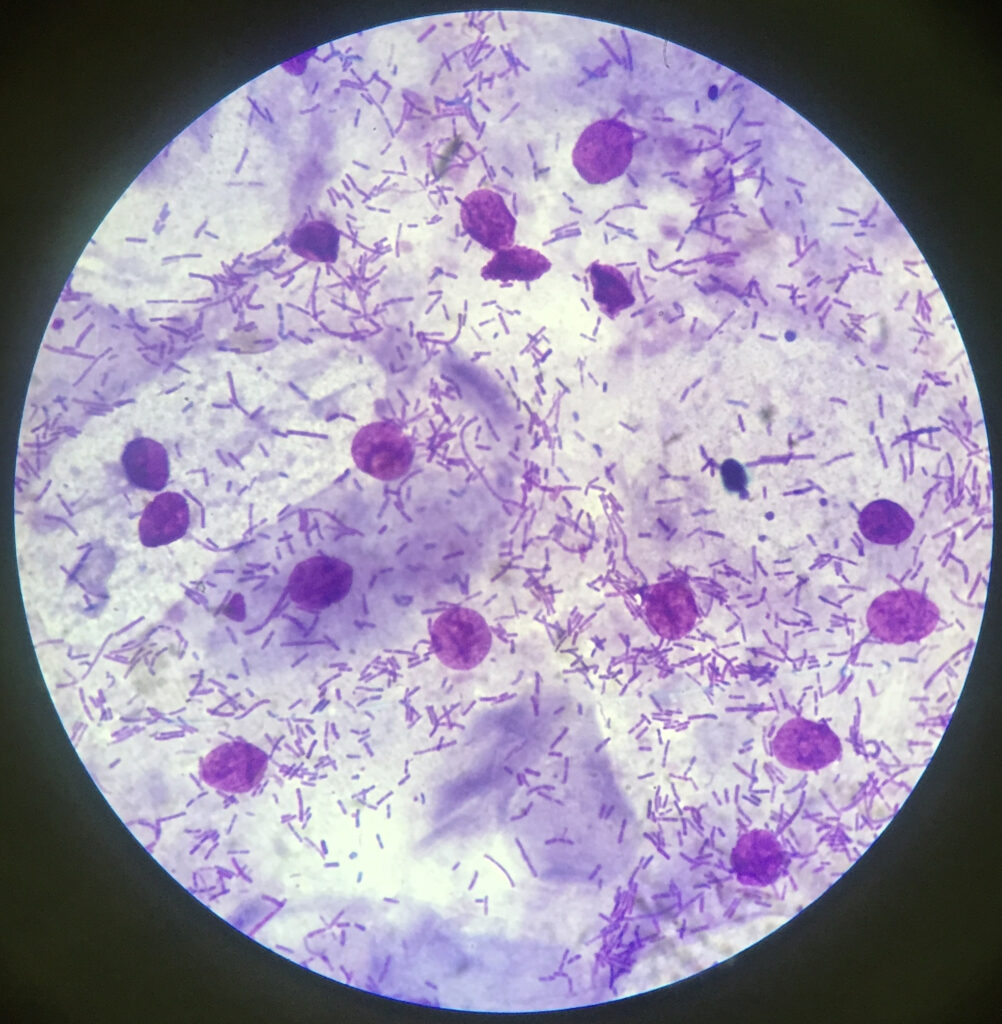- Uclear® is the only pateneted D-Mannose ingredient not he market that may help with urinary tract infections
- It works by attracting bacteria to latch onto it and then flushing it out of the urinary tract
In this article, we dive into precisely what D-Mannose is and how it works and affects the body. Most importantly, we take a look at how science demonstrates the effectiveness of D-Mannose in addressing the symptoms accompanied by UTIs – something millions of women and men deal with regularly.
What is D-Mannose?
D-Mannose is a non-essential, naturally occurring simple-sugar, known as a monosaccharide. We call simple sugars monosaccharides because they only consist of one sugar molecule (Get it? mono, meaning “one”).
D-Mannose can be synthesized in the body and converted into and from glucose as a nutrient for vital metabolic processes (it can do this since glucose has a similar D-Mannose structure).
D-Mannose has been a supplement of interest to researchers, doctors, and consumers alike for its potential benefit in treating urinary tract infections (UTIs).
**A note for those with insulin sensitivity: Yes, D-Mannose is a sugar, but not all sugars act the same way on blood glucose levels and insulin response. We know this thanks to the “Glycemic Index,” a method of measuring how fast a type of food can cause an increase in blood glucose levels.
Glucose is considered the simplest of sugars. It’s the primary source of energy for our bodies and has one of the highest glycemic indexes. Glucose is absorbed by the body and reaches organs rather quickly (within 30 minutes to an hour,) which is why it’s a concern for those with insulin-sensitivity conditions. Although D-Mannose is a simple sugar, it must be converted into glucose to be absorbed, making it a fast-acting sugar, but not as fast as glucose.
What makes D-Mannose even more interesting is that thanks to the D-Mannose to Glucose conversion, D-Mannose becomes a very attractive prebiotic that can be stored within the epithelial cells of the vaginal flora. This means that D-Mannose may not only help with UTIs but also with Bacterial Vaginosis. Read more about what bacterial vaginosis is in our other blog post “What is bacterial vaginosis?“
Where does D-Mannose come from?
D-Mannose can be found naturally within the body and in fibrous foods such as:
- Ground coffee beans (21.2%)
- Baker’s yeast (16%)
- Cranberries (0.04-0.14%)
- Apples (0.04-0.08%) (8).
The percentages next to the food indicate how much of its weight is in D-Mannose. So, for example, although we believe cranberry is an excellent source of D-Mannose, it only represents between .04 to .14% of its composition!
Based on the above-mentioned list, you might think you can drink more coffee to get more D-Mannose, but that’s actually not how it works, so don’t pick up the coffee just yet! The fibrous aspect of these foods is vital as they are oligosaccharides, or carbohydrates with many monosaccharides combined together, that require digestion to reap the benefits.
You would need to consume 10g of coffee beans, or 80 coffee beans, to get the necessary amount of D-Mannose required to address UTIs, and let’s be real, coffee is better sipped and enjoyed than chewed. So, unless you’re going to start eating coffee grounds, you can pass on this one.
However, this is where science comes in to help us extract just the D-Mannose so we can consume it in a more practical way.
How is D-Mannose made?
There are three ways to extract D-Mannose.
Let’s use ground coffee beans to explain how D-mannose is manufactured through the following processes:
Method 1:
One method is the extraction from plant sources – D-Mannose is extracted from fruits and plants (like coffee) in two steps; (a) hydrolysis and (2) precipitation.
(1) hydrolysis – Hydrolysis occurs in the first step, the breaking of chemical bonds in the presence of water. This can happen either by heat, acid, microbes, or enzymes.
(2) precipitation – In the second step, precipitation takes place, which is the formation of condensation from the water present in step 1. Ethanol is then used to precipitate D-mannose together.
In this method, we would utilize the spent coffee beans to extract the D-Mannose that is still present.
Method 2:
The second method is production through enzyme sources — D-Mannose can also be produced through enzyme sources by enzymatic conversion of D-glucose or D-fructose (forms of simple sugars) into D-Mannose. D-Mannose isomerase, Cellobiose epimerase, and D-lyxose isomerase are the enzymes involved in this conversion.
In this method, we wouldn’t use the coffee beans at all, but we would use the naturally occurring enzymes that create D-Mannose in a controlled setting.
Method 3:
The third method is produced through a chemical procedure – Different chemical reagents are used to make D-Mannose. For example, isomerization of D-glucose and oxidation of mannitol. However, temperature and other conditions need to be highly regulated. (9,10)
In this method, we wouldn’t be using coffee beans at all.

D-Mannose + Cranberry Powder
Our Happy V® D-Mannose + Cranberry was created for anyone who is experiencing symptoms related to Urinary Tract Infections. Eliminate the pain, burning sensation, constant need to urinate and vaginal irritation.
Learn moreNow that you know what D-Mannose is, where it comes from, and how it is made, let’s learn what UTIs are and how D-Mannose can help with UTIs.
What is a Urinary Tract Infection or UTI?
In the United States, UTIs are the third most common and frequently occurring vaginal infections in outpatients, with nearly 7 million women experiencing them annually. (1)
UTIs are considered an infection caused by bacteria in any part of the urinary tract, such as the kidneys, bladder, and urethra. Infections in the urethra, bladder, and kidneys are known as urethritis, cystitis, and kidney infection. Common pathogenic bacteria are responsible for causing these infections, which include: E. coli, K. pneumoniae, E. faecalis, etc.
Causes of UTI:
- Catheter
- Blocked urine
- Poor personal hygiene or wiping improperly (wiping back to front)
- Kidney stones
- Contraception
- Pregnancy
- Menopause
- Surgery
- Suppressed immune system
- Spermacides or tampons
- Antibiotics
- Sexual intercourse
Types of urinary tract infections:
- Uncomplicated UTIs:
These can easily be treated through a short antibiotics course. - Complicated UTIs:
UTIs that are resistant to many antibiotics. If you have an abnormality within your urinary tract or you have other underlying urinary tract conditions, you are more likely to develop complicated UTIs. These are much more difficult to manage since they will not be responsive to antibiotics. So the challenge here is that to stay UTI-free, you must be aware of adapting your entire lifestyle to make you less UTI-susceptible. More on that below
Activities that increase the risk of UTIs include:
- Being sexually active with multiple partners:
Every individual has a unique microbiome. The differences in bacteria, whether good or bad, may cause infections to occur. Exposing your body to a variety of microbiomes increases your chances of exposure to bacteria that do not agree with yours, potentially causing a UTI. - Using spermicides (chemicals that kill sperms for contraception):
Using chemical-laden products may throw off the pH of your system, making a more favorable environment for harmful bacteria. - Having previously suffered from a UTI:
If you’ve experienced UTIs before, there may be some dormant (inactive) E. coli bacteria lingering around that can be reactivated and cause recurring UTIs. One study found that Gardnerella, the bacteria that may be responsible for bacterial vaginosis, may reactivate such dominant E. coli.
Some common symptoms of a UTI include:
- Urge to urinate even after you just peed
- Burning sensations or pain while urinating
- Blood in your urine
- Pain in the lower abdomen or sometimes back
- Cloudy or smelly urine (2)
So how does D-Mannose help in the treatment of UTIs?
To understand how D-Mannose works, we first need to understand what happens to the body when a UTI occurs.
So what exactly happens when you get a UTI? Unwanted bacteria, such as E. Coli, groups together in the urinary tract, especially around the bladder, and creates a biofilm. A biofilm is an undesirable group of one or more microorganisms that grow on various surfaces of the body. Plaque accumulation on your teeth, for example, is a biofilm.
We know that E. Coli causes a whopping 90 percent of UTIs. This can be caused due to external E. Coli being digested, or something as simple as not wiping properly and the E. Coli found in your stool entering through the vagina.
Once E. Coli enters the urinary tract, they latch onto the vaginal walls and urinary tract lining through gene expression. Gene expression occurs when an organism processes information encoded into its genes to perform some type of action. In this case, E. Coli is being informed to spread out its fimbriae, which is the hook-like part in their anatomy and latch onto the urinary tract walls. This causes other bacteria to conglomerate, and thus the unwanted biofilm occurs.
Preclinical trials and research conducted in Europe suggest that D-Mannose inhibits the binding of harmful bacteria (like E. Coli) to the urinary tract walls. During the In Vitro study, it was discovered that the D-Mannose mechanism of action might attract the pili’s attention, the “fingers” of the E. Coli bacteria so that it binds to the D-Mannose molecule instead of the uroepithelial cells. Without binding, there is no UTI. This occurs because instead of E. Coli sticking to the urothelium (the epithelium of the urinary tract wall), D-Mannose manages to bind with the bacteria E. Coli and remove itself from the tract by flushing it out when urinating. So because the D-Mannose latches onto the bacteria, the bacteria cannot latch onto the walls. Make sense?
The urinary tract is filled with receptors (known as mannosylated glycoprotein uroplakin Ia) and these are the receptors that E. Coli binds to.
So when D-Mannose is present, the E. Coli will bind to the D-Mannose receptors, rather than the E. Coli binding to the receptors on the urinary tract lining.
With fewer bacteria in the bladder and urinary tract system, your risk of having recurring UTIs is dramatically decreased. Growing evidence and clinical literature suggest that D-Mannose might be used in the management and prevention of UTIs. (6)
To explain in simply: it’s all about stopping E. Coli from sticking to the vaginal wall in the first place. If the bacteria stick to the D-Mannose as an alternative place to hold onto, instead of the vaginal wall, it will get flushed out. This means we will have less E. Coli swimming around in the bladder and urinary tract. If there are fewer bacteria, then there are fewer chances of them conglomerating and creating the biofilm, which causes UTIs in the first place.
What is the D-Mannose Dosage For UTI?
Currently, there is no scientifically accepted dosage of D-Mannose known to successfully eliminate UTI’s. It really depends on the type of UTI you are suffering from. The two main types are 1) currently active UTIs or 2) frequently recurring UTIs.
For frequent UTIs, studies have recommended that the suggested daily dosage of D-Mannose is 2 grams. You can either have 2 grams of D-Mannose (in powder or a capsule form) daily or take it in a divided dosage of 1 gram twice a day.
For non-frequent UTIs: another study has shown that if you have non-frequent UTIs, doses of 2-3 grams multiple times a day work as well.
We don’t recommend either of those dosages as they are incredibly high, and studies have shown that D-Mannose can work in as little as 500mg once per day.
Can you take pure D-Mannose?
Here at Happy V, we always go two steps forward to help you combat vaginal infections and prevent them once and for all. We chose a different approach and combined Cranberry and D-Mannose to address UTIs in a 2-step fashion. The first step is to minimize the bacteria gene expression through a full spectrum cranberry blend so that the bacteria wouldn’t stick to the vaginal and urinary tract lining. As they float around, the d-mannose would attract the pili to hold onto the sugar and then flushed out when urinating.
How long does D-Mannose take to work?
According to research conducted on women who had UTIs (causative agent E. coli), they started to see results within 24 hours of taking D-Mannose. Although UTI symptoms start to alleviate within 24 hours, it may make the unwanted bacteria 2-3 days to go away completely.
However, this is one of few research studies conducted, and more studies must be done to understand both the correct dosage of D-Mannose for UTIs and how long it will take for the ingredient to work effectively.
What are the benefits of D-Mannose supplements?
When appropriately paired with synergistic ingredients, D-Mannose has incredible benefits.
D-Mannose and cranberry can work effectively together to flush out E.Coli and other UTI causing bacteria through the synergies of their mechanism of action. Cranberry works against E. Coli by minimizing the gene expression, or the method in which E. Coli lengthens its hook so that it doesn’t stick to the vaginal or urinary tract lining. The sugar from D-Mannose can pick up the E.Coli and remove it from our bodies when we urinate.
On the other hand, D-Mannose and vaginal probiotics offer a different benefit that women appreciate: tackling BV and keeping pathogens at bay. Let’s recall that D-Mannose is an excellent prebiotic. Prebiotics are the fuel that probiotics need to create lactic acid, hydrogen peroxide, and bacteriocins; the natural defenses that optimize pH while reducing harmful bacteria activity. D-Mannose can be found in many dietary supplements in the form of capsules, tablets, or powders. It can be by itself or with additional ingredients such as probiotics, vitamin c, and cranberry, just to name a few.

D-Mannose + Cranberry Powder
Our Happy V® D-Mannose + Cranberry was created for anyone who is experiencing symptoms related to Urinary Tract Infections. Eliminate the pain, burning sensation, constant need to urinate and vaginal irritation.
Learn moreHappy V Cranberry Urinary Defense utilizes the only patented D-Mannose on the market: Uclear.
The D-Mannose we use in our products is manufactured in our FDA registered facility and is a regulated substance.
It is received, tested, and manufactured in OUR cGMP, an FDA-registered facility in Miramar, FL.
What about D-Mannose as a prebiotic?
As stated before, D-Mannose tends to come from fibrous sources and is still a simple sugar molecule. As a fibrous source, it would have a lower glycemic index and thus be less prone to being transported to the liver to be stored as fat, and instead is favorable as uptake to the vaginal flora. This means that D-Mannose might be a preferred nutrient for probiotics hence serving as a prebiotic.
A prebiotic is a fibrous food substance that can help regulate the gut microbiome by providing a source of energy to the good bacteria in your digestive system. Let’s recall that probiotics consume prebiotics to make its byproducts such as butyrate, lactic acid, hydrogen peroxide, and bacteriocins to optimize vaginal pH and inhibit pathogen dominance. If true, this ingredient would be a real 1-2 punch to tackle overall vaginal and urinary wellness.
Is D-Mannose a safe alternative to antibiotics?
Natural solutions like D-Mannose, full-spectrum cranberry, and probiotics present a natural way of addressing UTIs and other vaginal issues without killing off all the good bacteria. Your vaginal flora and your gut, both need good bacteria to fight off the harmful bacteria. Antibiotics wipe out all bacteria (the good and the bad). If you choose to take antibiotics, we recommend taking these natural solutions along with medicines to balance out the two.
Antibiotics target all forms of bacteria, including good bacteria, also known as probiotics. There is a risk that both long term antibiotic use will increase the likelihood of bacteria becoming resistant to specific kinds of antibiotics. The short-term drawback is when medicines increase our chances of other vaginal infections like bacterial vaginosis and yeast infections when good bacteria are killed off.
A lot of research is being published where the effectiveness and safety of D-Mannose are compared with antibiotics. Results show promising evidence of D-Mannose’s effectiveness for UTIs. However, we still have two significant issues with studies available;
Studies on D-Mannose when compared to antibiotics in the treatment of UTIs
The most referenced study regarding the effectiveness of D-Mannose for treating UTIs’ symptoms came in 2013. In this study 308 women were split into three groups where group 1 (n=103) received 50mg of Nitrofurantoin, group 2 (n= 103) received 2grams of D-Mannose, and group 3 (n=102) received a placebo. The study found that the D-Mannose worked just as well as the commonly prescribed antibiotic at preventing UTIs over six months.
In another study from 2014, D-Mannose was once again compared to commonly prescribed antibiotics. This time it was trimethoprim and sulfamethoxazole, to see how effective it is for the treatment and prevention of frequent urinary tract infections. In this study, 60 women were used, and it was shown that D-Mannose was able to reduce UTI symptoms in women with an active infection. The great thing was that it was also more effective than the antibiotic controls for preventing additional infections.
A study conducted in 2016 using a sample size of 43 women with active urinary tract infections showed improvements to symptoms when using D-Mannose. The difference in this study, however, from those mentioned above, is that the participants knew what they were taking. This type of research is less effective than a double-blind, placebo-controlled study, where the participants don’t know what they are taking.
Although these studies do seem promising, further research and clinical trials must be conducted to ensure that there is repeatability in the studies. More studies are needed, but they’re required to make sure D-Mannose is an excellent alternative to antibiotics or can be taken alongside them to make treatments more effective.
Is D-Mannose safe?
Multiple studies have shown no toxicity having to do with D-Mannose and that it is well-tolerated for most adults and children when consumed orally. There have not been any safety or adverse-effect studies for women who are breastfeeding, pregnant, or trying to become pregnant.
Manufacturers have stated that possible side effects of too much D-Mannose may include
- Diarrhea or loose stools
- Bloating
- Extremely high doses might cause harm to the kidneys due to more glucose having to be processed
D-Mannose appears to be safe for use by people with diabetes.
It’s always essential to ask your doctor before use, and we advise you to share the products you plan on taking with your doctor. This can especially help you understand how D-Mannose may interact with other medications and supplements you may be taking. If you want a second opinion, ours are also available!
What science says about D-Mannose (effectiveness and dosage supported by science)
D-mannose is one of the natural supplements that might inhibit the colonization of harmful bacteria and prevent UTIs. (11)
Another study showed that D-Mannose supplement in powder form could significantly inhibit the recurrence of UTIs. D-Mannose attaches to pathogenic bacteria like E. coli and removes them from the urinary tract. (12)
One clinical study suggested that D-Mannose can act as a prebiotic and promote the growth of good bacteria. Its potential to correct the imbalance of microbial flora in the human body needs to be studied further. (13)
D-Mannose also plays an essential role in our defense system and has fewer side effects than current drug therapies. (16)
A study was conducted where 2g of D-Mannose was given daily with 200ml water for six months to see if it could reduce UTIs’ recurrence. Results showed a significant reduction in UTI recurrence. Patients also reported fewer side effects as compared to antibiotic treatment, Nitrofurantoin. (17)
Oral intake of 1g of D-Mannose twice a day for two weeks, followed by 1g of D-mannose twice a day for 22 weeks, significantly reduced the recurrence of UTIs. The time reduction for antibiotics was 57 days, while for D-Mannose was 200 days. (18)
Can D-Mannose cause kidney damage?
There is no conclusive evidence of this. Some reports have concluded that D-mannose can slow down the degradation of the type 1b protein and help the liver function better while reducing bleeding disorders and lower blood sugar with people who have carbohydrate-deficient glycoprotein syndrome type 1b.
The side effect of kidney damage may be more correlation than causation as recurring UTI and high antibiotic usage has been linked to kidney damage.
FDA Disclaimer: *These statements have not been evaluated by the Food and Drug Administration. These products are not intended to diagnose, treat, cure or prevent any disease.
When appropriately paired with synergistic ingredients, D-Mannose has incredible benefits.
- A-
- A+
When appropriately paired with synergistic ingredients, D-Mannose has incredible benefits.





